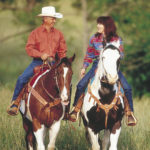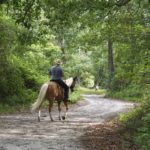Saddle?Select a saddle that is comfortable for you and your horse, and most importantly, one that fits your horse well.

Saddle Pad?The pad that the saddle rests on should be clean and of adequate thickness to provide even pressure and protection to the horse’s back. Choose a saddle pad that is made of a quick-drying, absorbent and flexible fiber, such as felt.
Breastcollar and Rear Cinch?If you are riding over hills or mountainous country, you mayfind a breastcollar useful. A breastcollar keeps the saddle from sliding back, especially when riding uphill. A rear cinch keeps the back end of the saddle from lifting off the horse’s back when riding downhill. If you plan to use any of these items, accustom your horse to the equipment before going on a trail ride.
Bridle?A variety of bridles will work. They can be made of leather or nylon, but should fit properly, holding the bit comfortably in place. Recreational riders should use headstalls with a throatlatch. If your horse accidentally catches its headstall on a limb, or rubs its head against a tree, a throatlatch will keep the entire headstall from coming off the horse’s head.
Reins?Split reins are often preferred for the extra length they give the rider. This is useful when leading your horse or letting it put its head down to drink while you’re still on his back. Split reins are arguably safer than a round (or roping) rein, as well. A round rein can be snagged by a low-hanging branch, or if the horse is loose with the reins down, it can get a leg through the rein?leading to injury and/or broken equipment.
Bit?One of the most important parts of the bridle. The bit you choose should be one with which your horse is comfortable, giving you adequate control without being severe to the horse’s mouth.
Halter and Lead Rope?These can be worn beneath the headstall or wrapped tightly and carried on the saddle. One of the benefits of using a halter when recreational riding is that you can tie your horse more safely to a tree or picket line than can be done with bridle reins. If a horse were to set back against the reins or break the reins, a fun ride can turn into a major ordeal. A halter and lead rope also allow you to graze your horse during rest breaks, which means less stress for you and more comfort for your horse.
Tie-Down?Ride with a tie-down only if you know how to properly fit it to your horse. For safety, if you do ride with a tie-down, always disconnect it when crossing any body of water. Horses have drowned because the tie-down hindered their ability to regain their balance after the animal slipped or fell into a hole.





